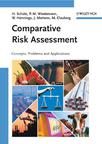比较风险评估
出版时间:2006-12 出版社:John Wiley & Sons Inc 作者:Hennings, Wilfried 页数:217
内容概要
Providing a catalogue of suggested solutions for different categories of issues, this book offers a balanced overview and methodological examples for the practical implementation of the CRA. It considers CRA in the USA, Europe and Germany, using case studies to analyze and exemplify the decision-making processes and challenges involved. The authors then go on to look at the practical lessons learned from these case studies, together with an in-depth discussion of the underlying scientific hypotheses. Sound scientific knowledge for everyone who makes decisions, whether government ministers, regulators, or company directors.
作者简介
Holger Schütz a senior scientist in the MUT (Man, Environment and Technology) Program Group at the Jülich Research Center, focusing on risk perception and risk communication, comparative assessment of environmental health risks and evidence assessment.
书籍目录
Foreword. Acknowledgements. Summary. 1 Introduction. 2 Concepts and Definitions. 2.1 Risk. 2.2 Danger/Potential for Damage–Hazard. 2.3 Incertitude and Uncertainty. 2.4 Risk Assessment. 2.5 Risk Evaluation. 2.6 Risk Comparison. 2.7 Risk Management. 2.8 Risk Regulation. 2.9 Risk Communication. 3 CRA in Practice. 3.1 Political Environment of CRA. 3.1.1 CRA in the USA. 3.1.2 CRA in Europe. 3.1.3 CRA in Germany. 3.2 Project Case Studies. 3.2.1 US EPA Unfinished Business Project. 3.2.2 Comparative RiskFramework Methodology and Case Study(USEPA). 3.2.3 Global Burden of Disease (GBD) Study. 3.2.4 ExternE Project. 3.2.5 Comprehensive Assessment of Energy Systems Project. 3.2.6 Classification of Carcinogenic Airborne Pollutants for the German TA Air Novella. 3.2.7 Summary. 4 The Empirical Foundations of CRA. 4.1 A Starting Point for Risk Comparisons. 4.2 Risk Comparisons as a Means of Risk Communication. 4.3 Procedural Challenges. 4.3.1 Framework: What is to be Kept in Mind when Determining the Systems Limit Options for CRA? 4.3.2 Risk Categories: What Inf luence Do They Have on Comparisons? 4.3.3 Attributes: What Inf luence Do They Have on Comparisons? 4.3.4 Assessment of the Attributes: What Inf luence Does the Measure of a Risk Have on omparisons? 4.3.5 Comparsons: What Inf luence Does the Nature of the Comparison Have on the Comparison? 4.4 CRA Negotiations Under Conf lict. 4.4.1 Pitfalls in the Evaluation of One’s Own Position and Interests. 4.4.2 Pitfalls in the Evaluation of Other Parties. 4.4.3 Pitfalls in the Evaluation of Suggestions. 4.4.4 Pitfalls in the Evaluation of Outcomes. 5 Conceptual Framework for an Integrated Comparative Risk Evaluation. 5.1 Methodological Problems of a CRA. 5.1.1 Problem: Uncertainty and Incertitude. 5.1.2 Problem: Evaluative Criteria. 5.1.3 Consequences for the Conduct of a CRA. 5.2 Methodology of Comparative Risk Evaluation. 5.2.1 Multiattribute Risk Evaluation: Quantitative and Qualitative Approaches. 5.2.2 Conduct of a Multiattribute Evaluation. 6 The Practical Implementation of CRA. 6.1 Limits of Comparability. 6.2 Goals of a Comparative Evaluation of Risks. 6.2.1 Preliminary Analysis. 6.2.2 Risk Assessment. 6.2.3 Risk Evaluation. 6.2.4 Risk Management. 6.3 Participation Models. 6.4 CRA Participants. 6.5 The Sequence of Events in a CRA. 6.6 The Organization of Communication. Appendix 1: Risk Metrics. Appendix 2: Multiattribute Comparative Risk Evaluation (MCRA). Appendix 3: Comparative Evaluation of Unclear Risks. Appendix 4: Comparative Evaluation of the Risks of Hazardous Incidents. References. Abbreviations of Organizations. Index.
图书封面
评论、评分、阅读与下载
用户评论 (总计0条)
推荐图书
- 土地与自然开发规范
- Sarbanes-Oxley法实施后的公司治理
- 90个世界级培训者的90个经典活动指南 90 World-Class Activities
- 关键绩效指标
- 房地产交易导论 Getting Started in Property Flipping
- 工作场所的沟通 Communication in the workplace / Baden Eunson.
- 如何实现你的百万美元计划
- 面向架构服务的傻瓜书 Service Oriented Architecture For Dummies
- 黑领结的选择
- 软件项目管理概述 Software Project Management For Dummies
- 烦恼的增长
- 房地产商成功之道 Success as a Real Estate Agent For Dummies
- 西点的领导才能课Leadership Lessons from West Point
- 应急管理技术 Emergency Management Technology
- 现金流转方案
- 上医情怀
- 英国公司法精要
- 西洋美术家画廊
- 学简笔画
- 右脑开发
- 创意营销·手绘POP
- 日本战争电影
- Symbian 操作系统平台安全指南 Symbian OS Platform Security
- 智能手机操作系统及Symbian操作系统辅导手册 Smartphone Operating System
- PROTEUS入门实用教程
相关图书
- 事业管理 Career Management
- 国际商务误区 Blunders in International Business
- 专卖店零售
- 无微不至
- 会赚钱者 - 纸币的秘密世界 Moneymakers
- 权威指导实战手册
- 简明抵押
- Pfeiffer 2007 年鉴
- 数字营销傻瓜书 Digital Marketing For Dummies?
- 少年英雄王二小
- 母亲与儿子的故事
- 信任电子社群用信任代理/Trusting agents for trusting electronic societies
- 商业写作 Business writing / Baden Eunson.
- 决策方式 Decision-Making Style Inventory
- 火工品技术
- SAP 企业服务架构精解 Mastering Enterprise SOA with SAP NetWeaver and mySAP ERP
- 精神销售
- 60秒领导
- 商业动力
- 管理学
- 非常秘密
- 泛珠三角与香港互动发展
- 非赢利营销最佳实践 Nonprofit Marketing Best Practices
- 在线企业参考大全 Starting an Online Business All-in-One Desk Reference For Dummies
- SAIC解决方案
